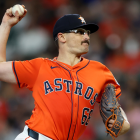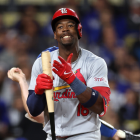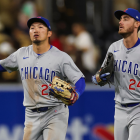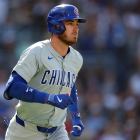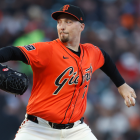As we barrel toward the Aug. 1 non-waiver trade deadline, you're no doubt fully acquainted with the rumors surrounding Jonathan Lucroy. The veteran Brewers catcher has another full year on his team-friendly contract, he's hitting the ball again in 2016, and he's healthy. Lucroy also remains a skilled defensive catcher. Since the Brewers are squarely in rebuilding mode, a trade of Lucroy is quite possibly in the offing.
Often, though, contending teams are hesitant to acquire a new starting catcher at such a late point in the season. That's understandable. After all, a significant portion of a catcher's value on the defensive side flows from his ability to handle the pitching staff. That, in part, flows from a familiarity and a cultivated relationship. If you throw a new starting catcher into the mix, there's no time to develop that most vital of on-field alliances. That's probably why a contender's acquiring a new regular catcher leading up to the deadline is relatively rare.
On that point, let's lovingly admire a lovingly assembled list of such acquisitions since the 2000 non-waiver deadline. These are catchers acquired within the month of July (or during the August waiver period) by a team that was at the time within 5.0 games of playoff position. These catchers then became the primary starting catcher from that point forward. Said list ...
- Charles Johnson, 2000 White Sox
- Paul Lo Duca, 2004 Marlins
- Brent Mayne, 2004 Dodgers
- Jason Kendall, 2007 Cubs
- Ivan Rodriguez, 2008 Yankees
- Bengie Molina, 2010 Rangers
- Geovany Soto, 2012 Rangers
- Kurt Suzuki, 2012 Nationals
So the past 16 trade deadlines and beyond have yielded trades for eight regular catchers that wound up on contending teams. As we said, it's not a common thing. Whether because of injury, ineffectiveness, or both, though, these clubs made such a leap.
And how did it go for them? On this front, we're mostly concerned with how the pitching staff responded to having a new battery-mate dropped in right in the middle of the season. To get a thumbnail look at this we'll look at the overall ERAs and K/BB ratios of each team on an overall basis and then when the catcher in question was behind the plate. Obviously, this kind of approach has some qualifiers -- mainly that it doesn't perfectly reflect the quality of pitcher used or the quality of opposition faced. Still, this should give us an idea of whether the pitching staff suffered to any significant degree once a new catcher was dropped in the mix ...
| Catcher, team | ERA w/new catcher | K/BB w/ new catcher | Overall ERA | Overall K/BB |
| Johnson, 200o White Sox | 4.45 | 1.48 | 4.67 | 1.69 |
| Lo Duca, 2004 Marlins | 3.64 | 2.17 | 4.10 | 2.18 |
| Mayne, 2004 Dodgers | 3.78 | 2.42 | 4.01 | 2.05 |
| Kendall, 2007 Cubs | 4.29 | 1.93 | 4.04 | 2.11 |
| Rodriguez, 2008 Yankees | 5.63 | 1.79 | 4.28 | 2.33 |
| Molina, 2010 Rangers | 3.93 | 2.57 | 3.93 | 2.14 |
| Soto, 2012 Rangers | 3.90 | 3.45 | 4.02 | 2.88 |
| Suzuki, 2012 Nationals | 3.46 | 2.60 | 3.34 | 2.67 |
As you can see, there's not much evidence that deadline catchers in the main cost their teams in terms of pitching performance. Of the eight teams listed above, four saw their team ERAs improve, and one saw it stay the same. On the K/BB front, three improved relative to the overall figures. If nothing else, there's little evidence that picking up a new regular catcher without an kind of "acquaintance period" exacts much of a cost on the run-prevention end. Maybe some of these teams called pitches from the dugout in order to ease the transition, maybe the need for catcher-familiarity is overstated, or maybe this is just One of Those Things. Also worth noting is that four of these catchers -- Kendall, Molina, Soto, and Suzuki -- made the jump across leagues in these trades, so they probably didn't benefit from a deep familiarity with opposing hitters.
With regard to all of this, the Dodgers in 2004 present an interesting case. Leading up to the deadline they traded Paul Lo Duca to the Marlins (along with Juan Encarnacion and Guillermo Mota) in an effort to fortify the rotation with Brad Penny and add more pop to the lineup with Hee Seop Choi. Oddly enough, both the Dodgers, who went on to win 93 games and the division, and the Marlins, who were 3 1/2 games out in the NL East at the time of the trade, went to get better pitching results after the trade.
So based on this very limited sample, no, teams should not necessarily worry about the pitching staff suffering if they were to, say, drop Lucroy into the job on the fly. Contenders/fringe contenders who don't project to get good value from the catcher position over the remainder of the season include the Rangers, Marlins, Tigers, and Indians. The Rangers may be the most desperate of all. On that point, it's worth noting that Rangers GM Jon Daniels was at the helm in 2010 and 2012, when Texas added new regular catchers at the deadline. Obviously, Daniels is not averse to such a step.
On that point, consider all of this to be ... developing.















